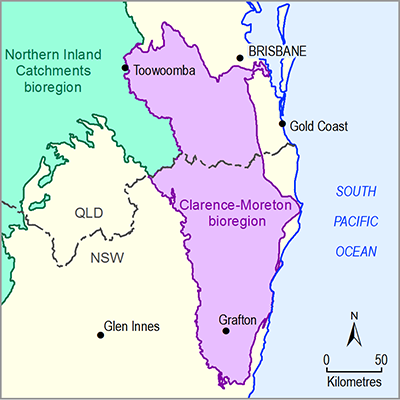- Home
- Assessments
- Bioregional Assessment Program
- Clarence-Moreton bioregion
- 2.1-2.2 Data analysis for the Clarence-Moreton bioregion
- 2.1.2 Geology
- 2.1.2.3 Statistical analysis and interpolation
- 2.1.2.3.2 Definition of the stratigraphic column
A three-dimensional geological model is generally composed of a series of units (layers) that are assembled with respect to their chronology and structural relationships. These units are defined by a set of boundary horizons, which represent the geological contacts between the different formations; a critical step in the modelling workflow is to determine the number of boundary horizons needed and identify their location in three-dimensional space (Raiber et al., 2012). During this step, the horizons that represent each geological layer are added to the model in chronological order, and the types of contacts between the different layers are defined. The decision on which layers are included in the three-dimensional geological model is underpinned by geological knowledge. Table 7 shows the layers that were included in the regional and/or bioregion-wide models. For example, the Grafton Formation and the Orara Formation (Bungawalbin Member and Kangaroo Creek Sandstone) are absent in the Brisbane river basin, therefore there was no need to include layers representing these units in the Brisbane river basin three-dimensional geological model. Another example is the inclusion of the MacLean Sandstone (the upper part of the Walloon Coal Measures) as a separate layer in the Richmond river basin three-dimensional geological model. In this area, there are sufficient data to differentiate it from the coal seams of the Walloon Coal Measures, whereas there are insufficient data elsewhere within the Clarence-Moreton bioregion. In addition, the relationships between the different horizons are defined during this step. In simple three-dimensional geological models of sedimentary basins (often referred to as ‘layer-cake models’), the relationships between the different sedimentary bedrock units of a sedimentary basin are usually modelled as conformable or unconformable contacts (where the base of each geological layer is represented by the top surface of the underlying layer) or as baselaps (where layers terminate along the lower boundary of a depositional sequence). However, the inclusion of the alluvium and the volcanic aquifers in the three-dimensional geological models of the Clarence-Moreton bioregion adds significantly more complexity, as the contacts between the alluvium and the underlying Lamington or Main Range volcanics or sedimentary bedrock, as well as the contact between the Lamington or Main Range volcanics and the underlying sedimentary bedrock, are eroded. Furthermore, unlike in simple ‘layer-cake models’, the alluvium and volcanic units overlie many different sedimentary bedrock units, and consequently, rather than representing them as formation tops, they are represented in the three-dimensional geological model as the ‘base of alluvium’ and ‘base of basalt’, respectively.
Table 7 Stratigraphic units included in the regional and bioregion-wide three-dimensional geological models
‘Y’ denotes that a layer is included in a three-dimensional geological model.
‘N’ denotes that the layer is present in the specific region, but that it is not included as a model layer.
Superscript ’a’ indicates that there are sufficient data available to differentiate the Maclean Sandstone from the coal seams of the Walloon Coal Measures.
Superscript ‘b’ indicates that the different layers of the Bundamba Group (i.e. Koukandowie Formation, Gatton Sandstone and Woogaroo Subgroup) are not differentiated.

Product Finalisation date
- 2.1.1 Geography
- 2.1.2 Geology
- 2.1.2.1 Methods
- 2.1.2.2 Observed data
- 2.1.2.3 Statistical analysis and interpolation
- 2.1.2.3.1 Three-dimensional geological model workflow
- 2.1.2.3.2 Definition of the stratigraphic column
- 2.1.2.3.3 Selection of input datasets
- 2.1.2.3.4 Representation of structural elements in the three-dimensional geological model
- 2.1.2.3.5 Characterisation of binding horizons of shallow aquifers (alluvium and basalt)
- 2.1.2.3.6 Characterisation of the bedrock stratigraphic units in the Clarence-Moreton bioregion
- 2.1.2.3.7 Isopach maps, depth to formation top and depth to base of formation
- 2.1.2.4 Gaps
- References
- Datasets
- 2.1.3 Hydrogeology and groundwater quality
- 2.1.4 Surface water hydrology and water quality
- 2.1.5 Surface water – groundwater interactions
- 2.1.6 Water management for coal resource developments
- Glossary
- Citation
- Acknowledgements
- Contributors to the Technical Programme
- About this technical product
